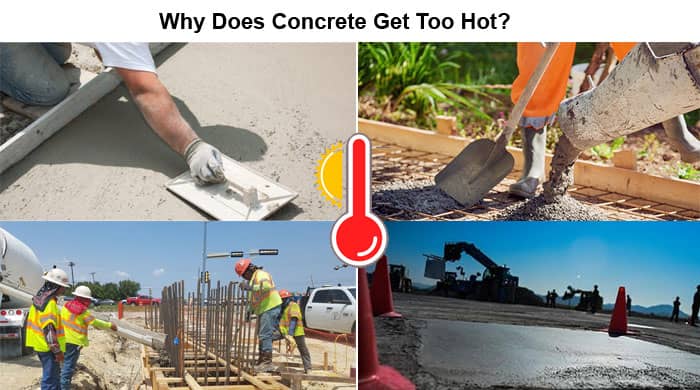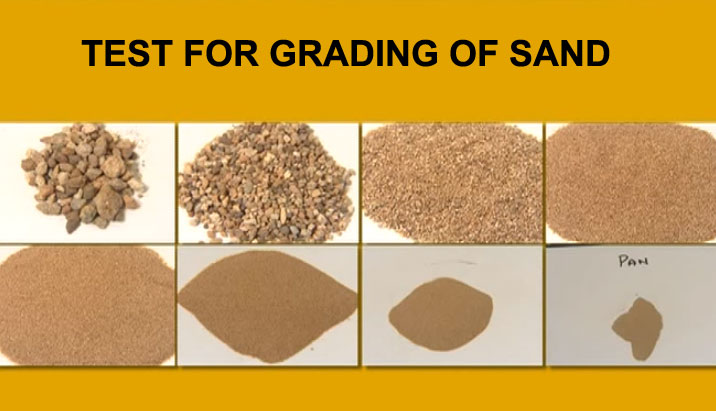Why Does Concrete Get Hot | Reasons and Curing Process
The sun and curing are the two main causes of concrete temperature. Sand, cement, and aggregate stone are the ingredients of concrete. A chemical process takes place when these three elements are combined with water, drying and hardening the concrete while also creating heat. Curing is the procedure, and it usually takes 28 days to complete. Concrete gets stronger and emits heat as it dries. The concrete cools once it has finished curing. The sun is the second and more frequent cause of heated concrete. Concrete is excellent at absorbing and retaining energy, just like all masonry products.
Sunlight heat can be effectively absorbed and stored by concrete. Typically, when people inquire as to why concrete surfaces become so hot, they are referring to summertime patios, sidewalks, and concrete surrounding swimming pools. You can immediately tell the difference when you move from grass or a wood deck to a concrete patio. Concrete can become very warm. And once the sun sets, it may continue to be like way for several hours. What gives, though?
We’ll talk about why concrete gets so hot in the sun later on and examine the curing procedure in more detail.

Sunlight
The sun is the primary cause of heated concrete. Although curing only lasts 28 days, concrete may be heated year-round by the sun. The primary source of heat for the entire planet is sunlight, which also has a significant impact on concrete.
Heat can be stored quite effectively in concrete. It can warm up to higher temperatures than the majority of other materials while dissipating heat more gradually.
Even concrete in the shade may easily average 70°F on a hot summer day, but concrete exposed to direct sunshine can reach 135°F. An instrument called an infrared thermometer is used by builders to check this.
Concrete can hold a lot of heat. This is mostly because of two things.
The surface of concrete is very dull and doesn’t reflect much light. The sunlight that strikes the concrete is instead absorbed.
Heat is essentially energy, which concrete’s composition is excellent at storing. It is a type of energy that the sun releases.
Concrete is exceptionally good at absorbing and storing heat, which explains why it feels so warm in the summer.
As concrete cools, it eventually releases that heat back into the atmosphere, raising the temperature in the area around it. This explains why cities have slightly higher nighttime temperatures than the nearby rural areas. By slowly releasing heat at night, the heat that was collected by the concrete throughout the day warms the city. Although people don’t hate the effect as much when it’s cold outside, this is also a factor in the winter.
Concrete Gets Very Hot
Concrete gets hotter than most other materials, in addition to retaining heat for a long time. Rarely does grass that is exposed to direct sunlight all day test at temperatures higher than 80°F. Concrete can achieve temperatures of 175°F, while wood can reach 90°F and composite decking 100°F. Most individuals would find that to be too hot to go barefoot on. Ever witness an egg being fried on hot concrete? States like Arizona and Nevada allow it.
Other than finding some shade, there isn’t much you can do to prevent concrete from being so hot in the summer. The only thing you can truly do is try to keep the concrete from absorbing the sun’s rays. You cannot apply sealants or additives to concrete to keep it from heating up.
Water cooling the surface greatly aids, but only while the surface is wet.
Air Temperature & The Earth
Concrete is heated by more than just sunlight. Your concrete’s temperature is also influenced by the Earth’s temperature and the temperature of the air.
The concrete can still be scorching during the summer when the air is warm but the sky is clouded. This is so because concrete absorbs heat from the Earth and the air in addition to the sun’s rays. Because of how well it absorbs energy, concrete is rarely more than a few degrees colder or hotter than the normal temperatures around it. For instance, the concrete will be the warmest if placed in the shade adjacent to wood, soil, grass, and tile. Concrete will remain warmer than other materials in the winter, and it will become hotter in the summer.
The temperature of the Earth permeates and penetrates concrete. This is why concrete may become very hot even in the shade in arid regions like Arizona. No matter what you do, concrete will heat up because of the combination of a heated earth and a hot air.
The Benefits of Hot Concrete
Sunlight heating up concrete can be beneficial. Many home builders are employing concrete’s high energy capacity as a technique to heat the home, despite the fact that many people complain that their concrete patio becomes too hot to walk on in the summer.
In so-called Passive Houses, extremely energy-efficient dwellings. The home is heated using huge insulated windows, concrete flooring, and walls. Windows allow daylight to enter during the day, which the concrete absorbs. The heat is released into the house at night by the concrete. All of that heat is retained within the house because to the exceptionally high levels of insulation and nearly airtight seal used in passive houses.
Hot concrete is a particularly energy-efficient way to heat a house. No matter the season or outside temperature, it is environmentally friendly, saves money on energy bills each month, and operates as long as the sun is shining. Although you’ll need to supplement with another heat source when the sun is down or obscured by clouds.
Curing of Concrete
After it is poured, concrete goes through two phases. Dripping is the first. Water evaporation causes the concrete to harden and become stronger.
Concrete does not, however, totally dry out. Masons will damp the concrete’s surface as it cures in some extremely hot places since curing needs some water to happen.
Concrete is strengthened by a lengthy chemical reaction and bonding between water and cement.
The curing process produces heat, a little-known phenomenon outside the building industry. This occurs as a result of hydration, a chemical interaction between cement and water. During these processes, which take place as the concrete continues to cure for around 28 days, heat is produced.
Curing is a crucial step in the concrete construction process. The potential of the concrete cannot be realized without it. The strength of concrete is expressed in pounds per square inch, or psi. The number 3500 on a Quikrete bag of concrete denotes 3500 psi. The concrete is stronger the higher the number. The number also denotes the time following complete cure. The figure represents a potential strength rather than a fixed value. A 3500 psi concrete is only about 1500 at 10 days. It only reaches its full 3500 psi after 28 days of proper curing.
The heat produced during curing is often not a problem in modest construction projects. However, for major building projects like pouring a bridge foundation or a dam.
In order to control its heat, concrete must be poured in a very specific manner.
How Much Heat Is Generated By Curing Concrete?
In general, concrete gains 10 to 15 degrees Fahrenheit during curing for every 100 pounds of cement used. To ensure that concrete cures for a sufficient amount of time, temperature control is crucial during the curing process. Concrete may be more brittle and weaker if curing is stopped before 28 days. Internal and exterior heat sources, as well as humidity and temperature, all have an impact on curing.
Why Curing Produces Heat
The exothermic process of concrete hydration produces heat as a result of chemical reactions. Heat is produced as moisture dries and cures over time.
Although the majority of people believe that concrete simply dries out with time, this is only partially true. In reality, it is undergoing a chemical reaction that modifies the water molecules and produces solids. Dry concrete is the result, although evaporation is not the cause.
Heat is produced as a consequence of this continuing chemical process. As long as the reaction is ongoing, heat will be created continuously.
Heat isn’t a major problem with the majority of residential concrete work, such as sidewalks, patios, steps, and simple footings. Concrete is kept warm in the winter and cold in the summer by builders. However, heat management calls for some additional precautions when large-scale industrial building is being done, such as pouring a concrete dam and a massive foundation. The structure may crack if the temperature of the concrete rises too much.
Internal expansion brought on by heat is more than the concrete can handle without crumbling. The maximum temperature difference between the interior and external concrete of big constructions should not be greater than 36°F.
Why Concrete’s Curing Temperature Matters
The reason concrete’s curing temperature matters is simple, strength.
Concrete can harden and become overly strong if it becomes too hot, which lowers the final psi. Concrete may not set and, thus, won’t reach its full strength if it remains cold. The strongest concrete is produced when it is allowed to cure between the ideal temperatures of 50 and 90 degrees. Concrete should be cured gradually over an extended period of time. Rushing or interrupting it usually causes weaker concrete to result.
The heat produced during hydration can be influenced by the concrete’s constituents in addition to using external techniques like soaking concrete when it’s too hot or insulating it when it’s too cold. The amount of heat produced as the concrete cures and sets can be changed by using different proportions of aggregate, sand, and cement. Because of this, depending on the scope of the project and the weather, the concrete’s formula also contributes to ensuring a sturdy end result.
The formula is created for you and is typically constant when you order concrete from a truck or purchase pre-mixed bags like Quikrete. On the other hand, you are in charge of modifying your materials when you mix your own concrete on site.
Why Hot Weather Is A Problem
Hot weather hastens the evaporation of water, which is a factor in the curing of concrete. The concrete dries out too quickly as a result, which hinders curing. In the chemical process that hardens and reinforces concrete, water plays a significant role. The concrete will become less durable if there is not enough water to react with the cement.
It might be essential to add more water to allow for curing. Concrete’s ability to cure at higher temperatures can be influenced by the rate of temperature change, the kind of aggregate, and constituent ratios.Masons work around this problem by pouring concrete when it’s cooler outside and misting it with water to keep it moist.
Why Cold Weather Is A Problem
Concrete pouring and curing in extreme cold and heat is equally hazardous. Concrete must receive a specific quantity of heat in order for the chemical reaction to take place when it cures. This means that because one of the fundamental ingredients in the curing process is water, it will basically freeze if the outside temperature is too low. This often happens at about 50°F.
It’s crucial to pour concrete when the surrounding temperature is ideal. Concrete can become weak if it is excessively hot or cold during the curing process.
Concrete warming blankets can be used to maintain the proper temperature of the concrete when you have no other option than to pour in less-than-ideal circumstances.
When pouring concrete in the cold, be sure you have these on hand.





